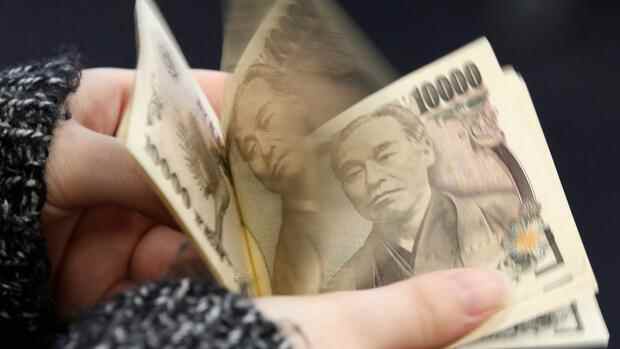Tokyo In times of crisis, the Japanese yen usually serves as a safe haven asset. Since the outbreak of the war in Ukraine, there has been concern in Japan that the national currency could appreciate in value. Instead, the opposite has happened: the Japanese currency is one of the biggest losers this month against the US dollar.
The yen has recently lost around three percent of its value compared to the world’s leading currency. The US dollar has risen above 118 yen for the first time in more than five years. And that may not be the end of it, predicts Tohru Sasaki, currency researcher at JP Morgan.
The decisive factors are the rapidly rising commodity prices and their effect on the Japanese trade balance. “A vicious circle of deteriorating trade balance and falling yen may have started,” says the analyst. “Hence, the yen is not rising even now when investors are looking for less risk.”
Japan is a large importer of commodities traded in dollars. However, the weaker the yen, the more expensive these imports become – Japan has to spend more yen to be able to afford these imports in dollars. So the rate of the Japanese currency continues to fall. This in turn drives the deficit.
Top jobs of the day
Find the best jobs now and
be notified by email.
JP Morgan expert Sasaki predicts that the yen could fall to 121 yen per dollar by the end of March. The strategists at broker SMBC Nikko Securities even consider an exchange rate of 125 to 130 yen per dollar to be realistic if the price of crude oil settles at 110 to 120 dollars per barrel. However, some market observers are even warning of oil prices going beyond the $150 or even $200 mark.
The trade balance for February published on Wednesday underscores this danger: The trade deficit – i.e. the excess of the value of imports compared to the value of exports – was 668.3 billion yen (5.15 billion euros), more than five times as high as economists interviewed by the Reuters news agency had expected in advance. As early as January, the deficit was 2.2 trillion yen.
Takeshi Minami, chief economist at the Norinchukin Research Institute, expects the trend to continue. “It is very likely that the trade deficit will continue to widen,” he told Reuters. Because car exports would not grow sufficiently stably given the lack of chips and problems in the supply chain, while imports would become more expensive due to rising oil and gas prices.
Read here >> The myth of the end of dollar dominance
The pressure on the trade deficit and thus the yen could increase if the US boycotts more than just Russian oil and gas. There is a risk that either US President Joe Biden or the US Congress will pass so-called secondary sanctions that would penalize foreign governments and companies for energy trading with Russia.
In that case, Japan would have to stop imports from the Russian fields on the Russian island of Sakhalin and in the Arctic, which it helped build. Dependence on Russia is much lower than in the case of Europe, for example. But especially for liquid gas, Japan would then have to bid on the spot market with Europe, which could drive up the already enormously high prices even further.
In addition and to make matters worse, Japan’s central bank is also hardly cushioning the fall of the yen. Their ultra-loose policy had already weighed on the yen before the Ukraine war.
Since the price pressure in Japan is far lower than in the USA or Europe, the central bank is keeping interest rates at zero percent. Other central banks, on the other hand, have long reacted to inflation with higher interest rates. This makes investments in these currency areas more attractive, which also strengthens the respective currency.
Markets do not expect a course change from Japan’s central bank
The monetary policy committee of the central bank meets on Thursday and Friday. The most recent development is increasing the pressure on the monetary authorities to take countermeasures and end the ultra-loose monetary policy.
Investors will therefore pay close attention to whether the weak yen plays a role in the central bank’s statements. However, Kentaro Koyama, the chief economist at Deutsche Securities Japan, assumes “that the Bank of Japan will maintain its current policy”. Because the economy threatens to slow down, while the inflation target of two percent has not yet been reached.
The expectation of a widening interest rate spread between Japan and above all the USA generally speaks for a weaker yen. The Japanese currency fell from 103 to 114 yen to the dollar between February and October 2021.
In addition to commodity prices and the trade deficit, monetary policy could also weaken Japan’s currency, warns Yujiro Goto, foreign exchange expert at Japanese investment bank Nomura. Markets would expect a rate hike in the US this month, the analyst said. “As upward pressure on the dollar returns, pressure is also building on the dollar-yen exchange rate, which is sensitive to interest rate spreads.”
More: Turkey gives savers guarantees and stops the lira from falling – but the price is high


